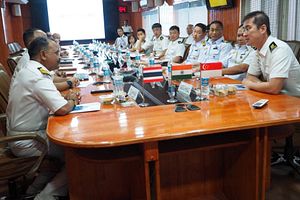Last week, Thailand’s navy chief paid his introductory visit to Singapore in his current capacity. The trip underscored the defense ties underway between the two Southeast Asian states amid wider regional and domestic developments.
As I have observed previously, Thailand and Singapore have a defense relationship that includes not only traditional aspects like exchanges, visits, and exercises, but also components such as an overseas training area for Singapore in Thailand, one of several arrangements that the city-state has with select partners, and minilateral and multilateral interactions including those within the ASEAN framework, the Cobra Gold exercises, and trilateral drills with India.
The development has continued on over the past year as well amid wider regional and domestic developments. Singapore and Thailand countries held ASEAN chairmanships in 2018 and 2019, respectively, and both are also experiencing domestic flux, with Thailand finally holding an election in 2019 and Singapore preparing to do so in the next year or so amid a leadership transition away from current Prime Minister Lee Hsien Loong.
This week, the defense aspect of the relationship was in the headlines again with the visit of Thailand’s navy chief to Singapore. Luechai Ruddit, the commander-in-chief of the Royal Thai Navy, paid what was his introductory trip to Singapore in his current capacity. Luechai has held the position since October 2018 and has presided over some key developments within Thailand’s defense approach, including the purchase of assets from China and the restructuring of Thailand’s maritime agencies to address challenges such as illegal, unreported, and unregulated fishing.
Luechai’s trip lasted from January 20 to January 22 and consisted of a series of interactions. He met with a range of Singaporean officials including Chief of Defense Force Melvyn Ong, Chief of Navy Lew Chuen Hong, and Defense Minister Ng Eng Hen. Singapore’s defense ministry did not disclose any details about the private deliberations, noting that Luechai’s visit “underscores the close and longstanding bilateral defense relations between the two countries.”
Apart from these meetings, Luechai’s trip included other interactions as well. For instance, per MINDEF, an aspect of his program involved a trip to Singapore’s military facilities including RSS Singapura-Changi Naval Base.
To be sure, Luechai’s trip was just one among many interactions between Thailand and Singapore on the defense side. And, unsurprisingly, little was publicly disclosed about the private interactions that he had with top Singapore officials. Nonetheless, such interactions will continue to be important to monitor to get a sense of wider developments in the bilateral defense relationship.
































